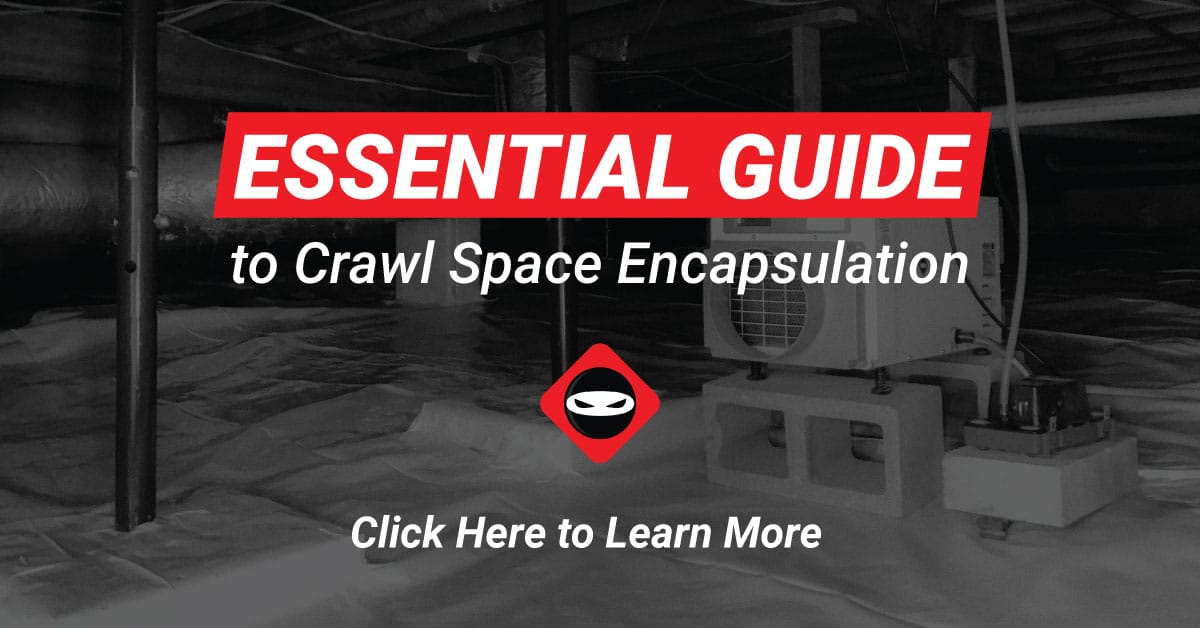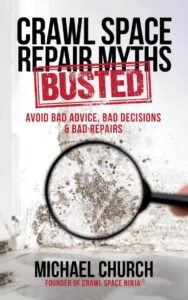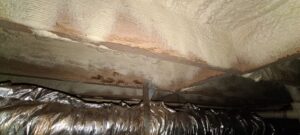Many homeowners ask us, “What is the best way to insulate my crawl space?” That depends, is your crawl space open or closed? Are you looking to air seal or create a thermal break or both?
Best Way to Insulate Closed Crawl Space
If your crawl space is closed or encapsulated there are several ways to insulate. We recommend foundation wall insulation as recommended by the Department of Energy. Foundation wall insulation comes in several forms. Foam board, spray foam, or insulation vapor barrier are the most commonly used for crawl space encapsulation projects. But we have seen contractors install fiberglass on foundation walls. This is not recommended.
Choosing the Right Foundation Wall Insulation
The type of foundation wall insulation you choose depends on the type of wall, budget, and if you will hire a crawl space contractor or do it yourself. Brick or stone crawl space walls are insulated differently than block or concrete. DIYers may not have the fastening tools of a contractor and could choose to use an insulation vapor barrier. Whatever method you choose, make sure it will last and consult a professional if needed to help you decide.

Attaching the Foam Board Insulation
There are several ways to attach foam board insulation to the cinder block or concrete walls. Some installers use a foam board adhesive while others attach the foam board using screws or masonry nails. Since adhesives can fail over time, we recommend screws or nails. It is also a good idea to spray foam the joints of the foam board. Similar to mudding drywall in order to prevent moisture from escaping from between the panels. Here is a video showing how Crawl Space Ninja attaches foam board.
Insulating Open Crawl Space
When the crawl space is open or vented it is also open to moisture, high humidity and whatever nature throws at it. The best way to insulate your crawl space when vented is to install fiberglass batt insulation in the sub-floor. This way the sub-floor becomes the thermal break to help keep the cold crawl space air from transferring to the living space.
Crawl Space Insulation: Open vs. Closed Considerations
Closed crawl spaces keep cold and hot air out. Open crawl spaces allow cold or hot air to enter the crawl space. Other materials like rock wool and spray foam can be used to insulate the floor of your crawl space. Keep in mind floor insulation can trap moisture from a leak or high humidity. We try to stay clear of covering the entire sub-floor with insulation because we are typically closing crawl spaces. But focusing on air sealing major sub-floor gaps is recommended whether your crawl space is open or closed.
Ready to find out more?
Drop us a line today for a quote!
Click HereAir Sealing the Crawl Space
Air sealing the crawl space is a great way to make your home more comfortable. Drafty homes are homes with little to no air sealing. Most insulation installed in homes built today do very little to air seal or reduce drafts. Many insulation contractors are focused on R value or type of insulation.
Watch this video to discover 3 critical areas you should air seal in your crawl space.
Conclusion
The best way to insulate your crawl space and the rest of your home is a combination of air sealing and thermal breaks. We feel an encapsulated crawl space is better when the foundation walls are insulated. Crawl space humidity and standing water in the crawl spaces are easier to control with the Ninja Crawl Space Encapsulation System.
Contact Crawl Space Ninja for Basement Waterproofing and Encapsulation
Please contact us to schedule your assessment to fix your crawl space, basement issue.
Do you need help with mold removal, crawl space encapsulation, crawl space insulation, vapor barrier, waterproofing, foundation repair, basement waterproofing, or controlling humidity in your crawl space?
If you live in Georgia, Delaware, North Carolina, South Carolina, Tennessee, or Kentucky, Crawl Space Ninja can help!
Also, let us know in the comments below if you have an idea for a new blog topic.
DIY Crawl Space Repair
Perhaps you’d like to tackle your own crawl space repair. Visit our DIY Store.
Join Crawl Space Ninja as an Owner
Learn about Crawl Space Ninja Franchise opportunities.


Michael Church’s Crawl Space Repair Myths-Busted book was written to help you Avoid Bad Advice, Bad Decisions, & Bad Repairs.
“This book is the Cadillac for crawl space information and Michael Church is your experienced driver. What can I say? It’s just an amazing read.” 5.0 out of 5 stars The real deal.
Other Recommended Articles
Here are 3 more crawl space insulation articles to help improve your homes energy efficiency.
Spray Foam Insulation
Is Spray Foam Good for My Crawl Space Sub-floor?
Read moreFoamboard Advesives
Can I Attach Foamboard with Adhesives?
Read moreRemove Fiberglass
Should I Remove Crawl Space Insulation?
Read more

23 thoughts on “What is the Best Way to Insulate My Crawl Space”
So do you not want to take the foam board all the way to the bottom and do you take the top of the foam board to the 3″ mark from the top of the wall or do you take the top of the foam board a little below 3″ from the top so you can install the foam board? Thank you
If the ground is level and you can get the foam board to the ground that is great ONLY if you are using ground contact foam board. Many foam boards are not designed to touch the ground and are not approved for crawl spaces. The gap at the top depends on your local code. In TN requires 3 inch minimum gap. GA 6 inch minimum gap.
In watching the foam board installation video, it appears that the vinyl vapor barrier is put up over the foam board. Is this correct? Also, are the open seams and holes (allowing pass-through of pipes) in the foam board sealed?
Hello, we install vapor barrier over foam board and use spray foam sealant as needed to fill voids, gaps. Thank you and hope that helps.
As a follow-up, do you typically fasten the vapor barrier directly to the foam board, to the foundation wall above the foam board, or somewhere else?
normally to wall above foamboard.
What type of foam boards would be ok to use around crawl space walls as a vapor barrier?
Hi Ben, we have a DIY store with some wall insulation options. Here is a link. The foamboard on the link is the only type we use and recommend. https://diy.crawlspaceninja.com/wall-insulation/ Hope that helps.
Code in our area requires an ignition barrier on the foam insulation. They recommend using a non-plastic foam to take care of the problem. Do you have a recommendation for that type of product?
The foamboard we use may work. Here is a link https://diy.crawlspaceninja.com/foam-board-insulation/
Hi Michael,
Just starting my encapsulation. My crawl space has a lot of 4′ high concrete block walls. I have a few questions about securing the insulation and the vapor barrier:
1. How many Hilti plastic fasteners do you recommend installing in a 4′ x 8′ sheet of foam insulation to the block wall BEFORE the vapor barrier is installed?
2. To secure the vapor barrier, you run a line of fasteners above the foam insulation, through the vapor barrier, through the Butyl tape, into the block wall. What is the distance between the fasteners used to hold the vapor barrier?
3. Do you then install fasteners through the vapor barrier, through the foam insulation into the block wall?
Thanks for the awesome info.
Hi Dwight, all great questions. I have forwarded them to our DIY Specialists to email you. In the future you can contact them here https://diy.crawlspaceninja.com/contact-us/ hope that helps and thank you.
Hello I have a peered home in Louisiana I thought about taking some 1 inch foam board and just attach it to the two by sixes underneath my house that would leave a 6 inch air gap between the floor and the foam board do you think that’s sufficient or in Louisiana heat. It’s mainly for keeping the house cooler
Jason I think that is a good idea but the air gap can hold moisture and cause mold issues. I have heard of others in your area applying spray foam to the sub-floor too. Whatever you do, try to make sure the wood is dry first and keep in mind all sub-floor insulation can trap humidity and hide water leaks from above. Since I am not familiar with your area, you may want to contact a local crawl space or insulation company for some advice.
Michael,
If I have existing air vents (can slide open or closed), is installing foam board installation still advantageous, or do the vents eliminate the benefit? Thank you so much!
I think the foamboard still adds a better R value in climates that can experience extreme weather. The foamboard and spray foam tends to seal a little better than the slider vents too in my opinion.
I’ve seen termite resistant EPS by a company that impregnates it with termite repellant, and I think another company manufactures their EPS with mild control solutions added. But I haven’t seen both in one product. Looks like you use the former because your foam description does not mention mold resistance. The foam on foundation wall is in contact with water 24/7 (due to wall being always moist) with no space to evaporate. Have you checked the foam years after installation for mold behind it?
Or, is the idea that as long as you keep that mold encapsulated behind foam and plastic – let it flourish there? Not being critical, just trying to understand.
Hi Stan, the product we install is impregnated with a termite resistant solution and allows moisture to wick through to help keep moisture from being trapped by foundation walls and prevent the foam from breaking down.
Michael, thanks! But what’s the point of sealing crawl space from moisture released by walls, if we’re letting this moisture wick through? Is it minimal, neglectable quantity that wicks through? Does the foam become soaked with water while wicking it through? Does mold grow between foam that you use and walls, and if not – why not?
It would be great of you making a video that explains exactly how this all works, but meanwhile, could you please clarify this?
We put vapor barrier over the insulation to direct moisture to a waterproofing system. Never had an experience with mold on walls unless walls are painted and mold food source is there (paint). There is no food source between foam board and walls. Insulation pushes water down as well, very tiny amount wicks through. I have placed water on foam board and it evaporates before it can penetrate to any eye noticeable degree. It never creates a “seal” to the wall so not seeing it trap water.
Thank you, Michael. I’m still struggling to understand a couple if things. You said that you put vapor barrier over insulation. Doesn’t the vapor barrier prevent a bit of moisture that wicked through EPS to evaporate? The vapor barrier would further trap moisture in EPS, wouldn’t it?
I trust your observations of not seeing mold behind wall insulation! But I’d like to understand how that’s possible..
Also, all articles and video demonstrations that I’ve seen show that XPS absorbs significantly less water than EPS. Could you please clarify your choice of EPS vs XPS? Does EPS have qualities that we need for this application that XPS lacks?
Hello, just bought an old house in Maine (1920). Bedroom is on metal posts over open ground about 1-2 ft clearance. You can see the actual floor under the crawl space! No insulation. Inside room there is wall to wall on floor. Very cold. It’s Nov and I have little time to treat properly before snow. Question is it safe to simply staple sheet plastic to joists under the floor in crawl space and then put vapor barrier over bare ground secure with stakes and then wrap bottom of room with sheet plastic? Thanks for any advice we’re freezing.
Hi Laura, we never recommend adding plastic to the wood subfloor. It can trap moisture and cause mold problems. Can you get under their with some canned foam and seal major air gaps in floor? That would help minimize cold air drafting into your home. Hope that helps. Stay warm in Maine – beautiful place. I was able to ski there when I was stationed in Boston area.